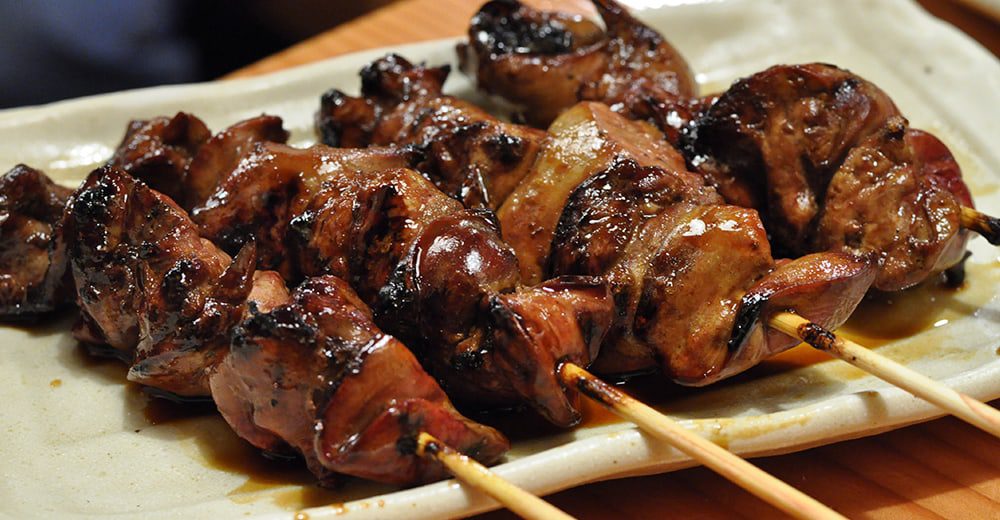Food author Scott Haas explores Japan’s yakitori joints and how they’ve changed significantly over the years.
When I first came to Japan about thirteen years ago, yakitori joints were filled with chain smoking salary men throwing back draft beer while scarfing down grilled chicken, and everything about being there was unappealing.
There’s been a big change. These days, yakitori can mean date night, a first rate list of French wines, single breed chickens, and old school music playing on state of the art sound systems. And all for as little as 2500 Yen per person, including drinks, tax, and service.
Each of the yakitori places in Japan follow a very similar formula, which is tweaked uniquely by every yakitori cook so that nothing tastes quite the same from one restaurant to the next.
The chicken is often single breed; the charcoal is bincho tan zumi; the sauce to dip or baste the chicken is a secret combination of sugar, soy, sake, and mirin; and, the customer can choose on the menu from all sorts of chicken parts served on skewers: Thighs. butt, wings, heart, liver, skin, cartilage, and tsukune (sort of a minced chicken pressed into a long almost hot dog shape).
You order each part, and one or two sticks arrive, and after you’ve eaten, you place the sticks in a cup or jar so the restaurant can tally up your tab. You might start with a draft beer and head into cups of sake or shochu (Japanese style vodka, only with a lower alcohol content that is about 23-28%).
You can also order grilled vegetables, depending on the season: Gingko nuts, asparagus, shitake, and so on. Many places do not have English menus, but you can find terms on the web and print out the list as well as point to your skin, thighs, heart, etc. One measure by connoisseurs of yakitori, if there is such a thing, is to judge a place by the quality of its tsukune.
Yakitori is typically served in the evening. The best places get crowded, and whether you’re looking to sit at a counter, a table, or or your haunches in a tatami room, reserve as soon as you’re able. Smoking is still, sadly, permitted in many restaurants in Japan, not just yakitori, but some places have no smoking areas, and it seems, too, that the habit of lighting one cigarette after another isn’t common any more.
There are dozens of yakitori restaurants in Tokyo, and lots and lots in every major city. How do you decide where to go? You can rely upon Michelin, and that’s fine, really.
BIRDLAND, for example, with one star, has a few outposts that are first-rate: Single breed birds with just the right amount of fat, not too much and not too little; an excellent choice of sake; cool jazz playing; and, yakitori cooks who work with focus, alacrity, and interest.

Photo: tripadvisor.com.au
The one in Ginza, next to Jiro’s, the very famous sushi spot, is a great place to start. There’s also a BIRDLAND in the basement of an office building of Marunouchi that is just as good–Bonus! No smoking!
FUKU, in Tokyo, is a cramped space with a less hoity-toity vibe than BIRDLAND and a younger crowd. The tsukune here has a great crust and a moist interior.
One of my favorite yakitori places in all of Japan is TORITO, and it’s in Kyoto, often jammed with conscientious medical students from a nearby school, with little booth-like areas and a long counter. The owner plays loop after loop of Beatles music, from when the boys were a band to the solo years, and somehow it all makes sense. You might feel as if you’ve entered “ Norwegian Wood,” the novel by Harumi Murakami, that made him famous.

Photo: tripadvisor.com
Near TORITO is another first rate yakitori joint: HITOMI. If you can get a reservation, and I wish you luck because it’s not easy due to its huge popularity, you’ll see a long counter, dark and beautiful lighting, lots of happy people, and then upstairs a brightly lit tatami room where you can sit on mats and savor the evening not feeling rushed (as you might at the counter).
Finally, should you find yourself far north, on Hokkaido, and in that prefecture’s capital city of Sapporo, do not miss SHIRO. This is as fancy as yakitori gets: A suave room, an extensive list of wines, and everyone around is Mr. and Mrs. Fancy Pants. But you’ll still get out for about 5000 Yen a couple if you avoid the best wines offered.

Photo: flickriver.com


